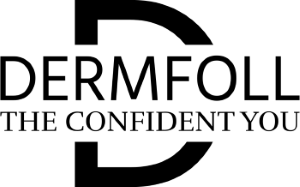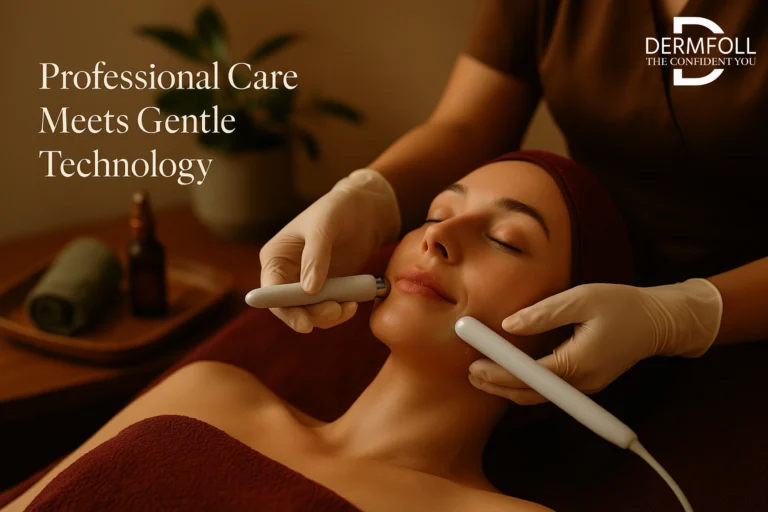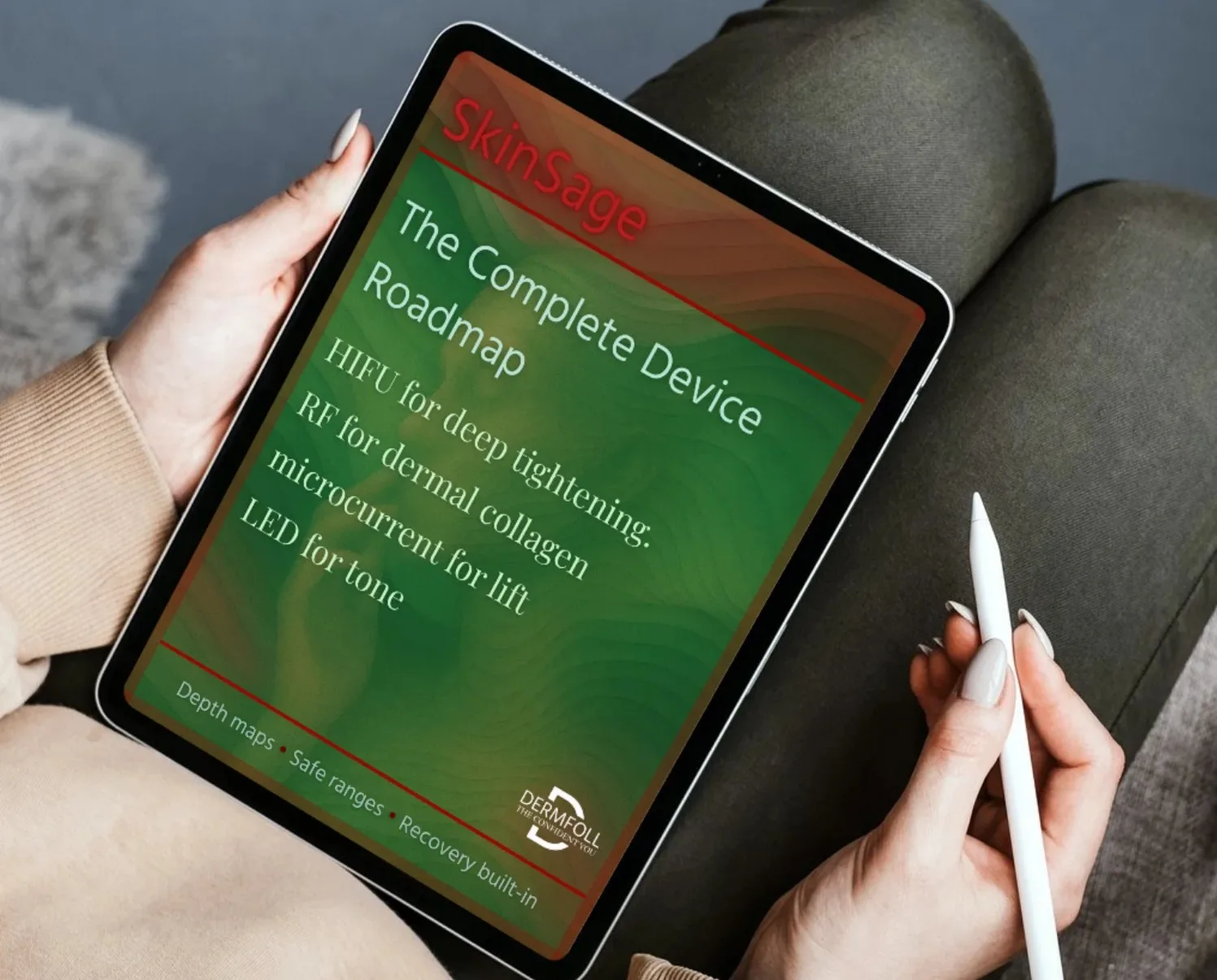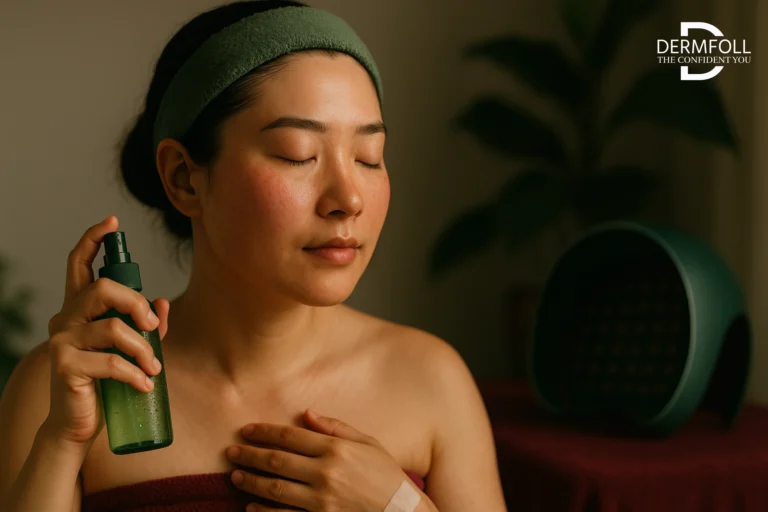Why Microcurrent Is Gentle Enough for Most Skin Types, Even Reactive Ones
If you’ve ever been curious about electrical facial treatments but worried about how your skin might react, especially if you’re prone to sensitivity, you’re not alone.
Let’s walk through why microcurrent electrical therapy is actually considered one of the most skin-friendly technologies available.
How Microcurrent Mimics the Body’s Natural Signals
Your body is already electric. Every blink, smile, and stretch is powered by micro-signals in your cells. Microcurrent electrical therapy simply follows that blueprint.
This type of therapy uses super low-level electrical currents, so small they’re measured in microamperes, to gently mimic the natural signals your body uses.
It’s not pushing your skin; it’s partnering with it. These currents recharge cellular energy (ATP), which helps your skin cells work like their healthier, more efficient selves.
If you’ve wondered, does microcurrent stimulate collagen? The answer is yes, and it does it by energizing fibroblasts that are responsible for collagen and elastin production.
“Microcurrent stimulation has been shown to increase ATP concentrations by up to 500% in treated tissues.” — Cheng et al.,
That ATP boost fuels everything from cell repair to new collagen, giving your skin that extra vitality, without causing stress.
Low-Intensity Stimulation: What Makes It Skin-Compatible
Here’s what makes microcurrent special: it’s so gentle that you often won’t feel a thing. Unlike EMS, which triggers visible muscle contractions and a tingling sensation. Microcurrent stays below the threshold of feeling. It’s like a whisper to your skin.
This makes it perfect for electrical facial treatments that don’t overwhelm sensitive types. You can even tweak intensity settings on most devices to match your comfort level.
“Microcurrents operate at such low intensity they’re often sub-sensory – providing stimulation without activating pain or temperature receptors.” — NESA Protocol Reference
That’s why so many people with rosacea or sensitive skin find it soothing rather than irritating.
Why Microcurrent Rarely Disrupts the Skin Barrier
Here’s the biggest win: microcurrent electrical therapy doesn’t damage your skin to deliver results.
There’s no heat, no exfoliation, no micro-tears, it leaves the outer layer of your skin (your barrier) intact.
That barrier is your skin’s first line of defense, and keeping it healthy is essential for sensitive types.
While some treatments rely on controlled injury to trigger a healing response, microcurrent skips the damage and goes straight to the benefits: better circulation, cellular regeneration, and collagen support.
“Unlike modalities that disrupt the epidermis, microcurrent stimulation works without breaking the skin barrier, making it ideal for sensitive or traumatized skin.” — Clinical Journal of Dermatologic Therapy
So if you’re looking for a smarter, gentler option that works with your skin – not against it – you’re in the right place.
🔶 Recharge Skin Energy with Gentle Microcurrent Therapy
AMIRO GlowBooster Microcurrent LED Facial Device
Sub-sensory microcurrent boosts ATP and firms skin without irritation.
FOREO BEAR 2 Microcurrent Toning Device
Smart adaptive current personalizes lifting intensity for sensitive or mature skin.
The Delicate Balance: Microcurrent for Reactive and Sensitive Skin
If you’ve ever flinched at a product that promised to be “gentle,” only to end up with a red, burning face, we get it. Sensitive skin doesn’t play by the same rules.
So how does something like microcurrent electrical therapy fit into that equation? Surprisingly well, actually. But like with anything reactive-skin-related, it’s all about balance.
What Makes Reactive Skin React? Understanding Barrier Dysfunction
First, let’s talk about your skin barrier, it’s like your face’s personal security guard. For people with reactive skin, that guard’s a bit overworked.
The outermost layer, called the stratum corneum, is thinner, drier, and less equipped to fend off irritants.
So even mild stimuli, like light heat or friction, can trigger inflammation or discomfort.
Age, genetics, and even climate can make this barrier weaker over time. And when the barrier’s down? Irritants sneak in, and your skin goes into full defense mode.
“Sensitive skin is notably associated with decreased ceramide levels and compromised lipid structure in the stratum corneum.” — Dermatologic Clinics, 2021
That’s why treatments that don’t disturb the surface, like microcurrent electrical therapy, tend to fare better with reactive skin types.
The Role of TRPV1 and Neurogenic Inflammation in Device Sensitivity
Now here’s where it gets nerdy (but stay with me). Your skin has tiny nerve endings called nociceptors. They’re there to protect you, but in reactive skin, they’re a little jumpy.
One key player? A receptor called TRPV1. Think of it like a tripwire: once activated, by heat, pressure, or even strong stimulation, it can cause itching, stinging, or redness.
Some devices, like EMS, can trip that wire because of their stronger currents.
Microcurrent, on the other hand, works at such a low intensity that it usually stays under TRPV1’s radar.
“TRPV1 activation plays a central role in cutaneous neurogenic inflammation – microcurrent’s sub-sensory current avoids this response in most users.” — Journal of Investigative Dermatology, 2020
This is why many people with sensitive skin feel almost nothing during a microcurrent session, just a quiet recharge happening beneath the surface.
Practical Guidelines for Using Microcurrent on Sensitive Skin
If your skin tends to freak out, don’t just jump in. Start slow.
Use a device with adjustable settings, always apply a thick water-based conductive gel, and stay hydrated (inside and out). These small things go a long way.
- Begin with a patch test behind your ear.
- Use a hydrating, oil-free serum underneath the gel.
- Stick to lower settings, and resist the urge to “level up” too fast.
- Avoid retinoids or acids 24–48 hours before treatment.
“Microcurrent is low-risk when used correctly – discomfort usually results from inadequate gel or overuse, not the current itself.” — Aesthetic Therapy Review, 2019
Think of electrical facial treatments like yoga for your skin: gentle, consistent, and most effective when you listen to your body. You don’t need intensity, you need intention.
Still feeling unsure? That’s okay. Trust and results take time, especially when you’ve got sensitive skin.
🔶 Soothe, Strengthen, and Lift Sensitive Skin Safely
AMIRO GlowBooster Microcurrent LED Facial Device
Gentle bioelectric stimulation enhances collagen while keeping the barrier intact.
FOREO BEAR 2 Microcurrent Toning Device
Intelligent sensors adjust microcurrent flow to avoid overstimulation or redness.
Long-Term Benefits of Microcurrent for Facial Health
So, you’ve been wondering: is this just a quick fix or something that actually improves your skin over time? Totally fair question.
The truth is, microcurrent electrical therapy isn’t just about the “lift.”
When used consistently, it works deep, at the cellular level, to support lasting changes in how your skin functions.
Let’s break down what’s really happening behind the scenes when you stick with those sessions.
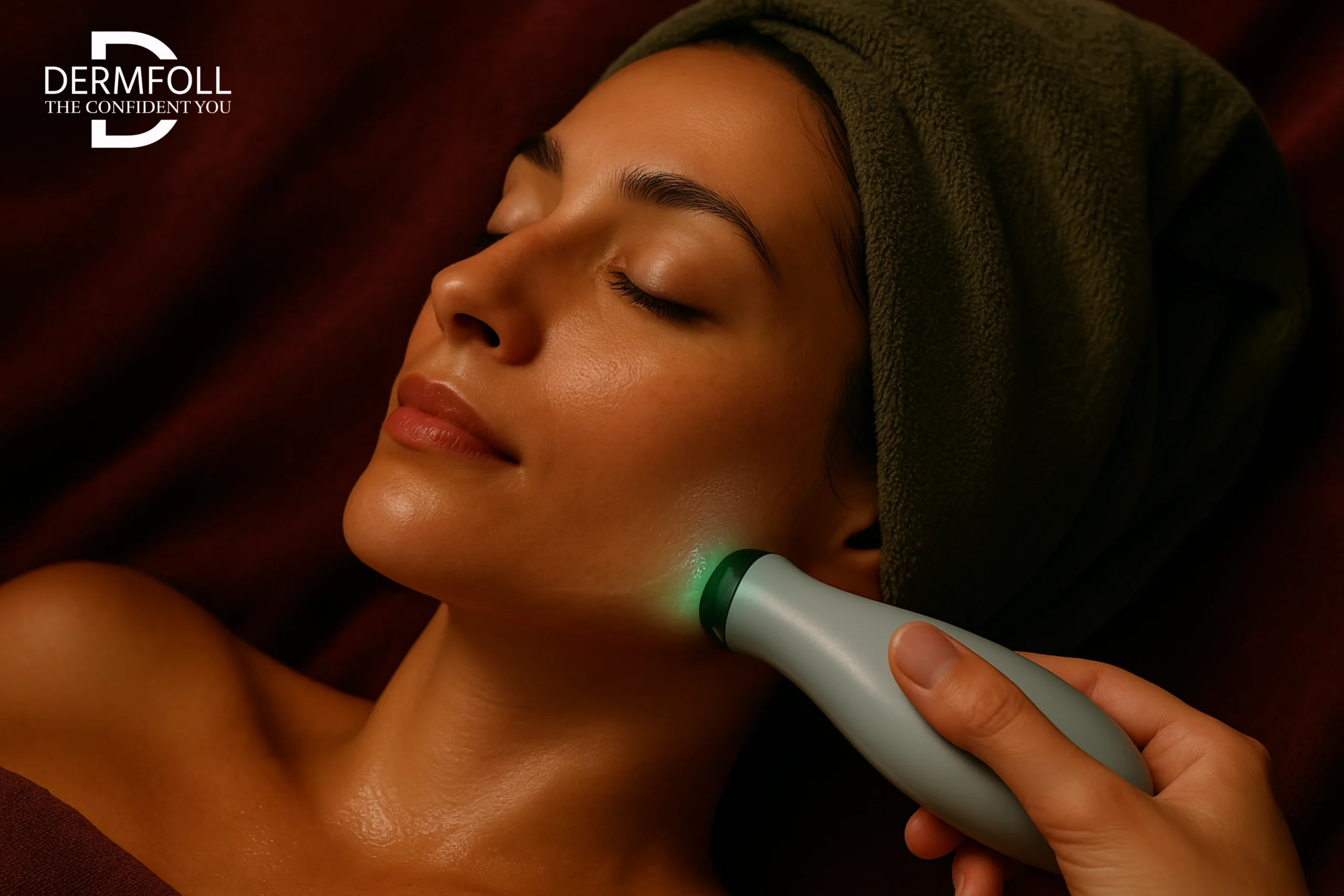
ATP Production and Cellular Energy: The Longevity Mechanism
Here’s a little skin science that might surprise you: your skin cells run on something called ATP (adenosine triphosphate), basically, their energy source.
As we age, ATP production slows down, which means slower repair, less collagen, and a more “meh” appearance.
What microcurrent electrical therapy and even EMS does really well is jump-start ATP production. Think of it like plugging your skin cells into a charger.
Studies have shown that microcurrent can increase ATP production by up to 500%, which is huge for keeping your cells youthful and efficient.
“Low-intensity microcurrent therapy enhances cellular metabolism by stimulating ATP production, which fuels regeneration and collagen synthesis.” — Cheng et al., 1982
And since ATP acts like stored energy, the results build over time, making each session more impactful than the last.
Muscle Tone and Lymphatic Flow: Gentle Lifting Over Time
Let’s talk lift, but not the kind you’d get from surgery. With microcurrent, it’s more like retraining your facial muscles to “remember” their younger, perkier shape.
It’s subtle, slow, and real. Over weeks or months of consistent use, you’ll notice your cheeks are sitting higher, your jawline is more defined, and puffiness? Way down.
That’s because microcurrent doesn’t just tone muscles; it also helps improve lymphatic drainage, essentially helping your skin clear out extra fluids and toxins that lead to that puffy, tired look.
“Microcurrent improves muscle responsiveness while supporting lymphatic outflow, leading to visible facial lifting and de-puffing.” — Journal of Cosmetic Dermatology, 2018
No tingling, no twitching, just a gentle electrical facial treatment that quietly refreshes your entire face.
Collagen and Circulation: Does Microcurrent Stimulate Collagen?
This is where the magic of consistency really shines. As your ATP stores build, your dermal fibroblasts (the collagen-making cells) start getting to work.
More collagen means firmer, more elastic skin. Over time, this strengthens your skin’s structure and improves its overall texture.
You’ll also get a noticeable glow, thanks to improved microcirculation. Better blood flow brings more oxygen and nutrients to your skin, and that’s what gives you that healthy, “just had a facial” look even on days you didn’t.
“Repeated low-level electrical stimulation has been shown to improve collagen density and microvascular circulation in facial tissue.” — Clinical Aesthetics Review, 2020
And yes, if you’ve been asking yourself, “does microcurrent stimulate collagen?” – the answer is a solid yes.
The beauty of microcurrent electrical therapy is that it supports your skin like a good workout routine supports your body: with small, steady steps that lead to transformative results.
🔶 Smart Lifting for Calm, Collagen-Rich Complexions
AMIRO GlowBooster Microcurrent LED Facial Device
LED-assisted microcurrents improve circulation and elasticity for long-term firmness.
FOREO BEAR 2 Microcurrent Toning Device
DualWave™ microcurrent tones facial muscles and energizes cells with adaptive precision.
CONCLUSION
We’ve covered a lot, but here’s a quick recap of what makes microcurrent electrical therapy such a standout in the world of electrical facial treatments:
- ✅ It mimics your body’s natural bioelectricity, making it gentle and biologically compatible.
- ✅ It’s sub-sensory and non-invasive, perfect for even sensitive or reactive skin types.
- ✅ It supports ATP production, giving your skin cells the energy they need to regenerate and repair.
- ✅ It promotes lymphatic drainage, reduces puffiness, and helps re-educate facial muscles.
- ✅ And yes, does microcurrent stimulate collagen? Absolutely. It fuels the fibroblasts that produce collagen and elastin.
All of this makes microcurrent a low-risk, high-reward option for long-term skin health and rejuvenation.
But what if you’re looking for something more intense?
In our next post, we’re diving into EMS vs. Microcurrent, what really sets them apart, and how to know which one’s best for your skin goals.
Stick around, it’s going to be a charged conversation. ⚡
